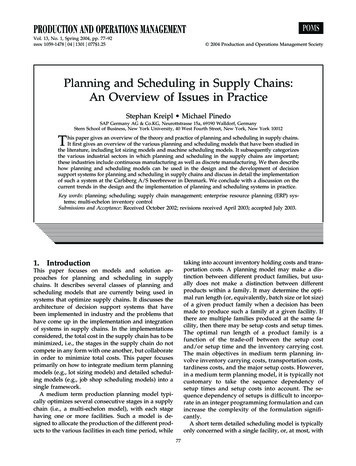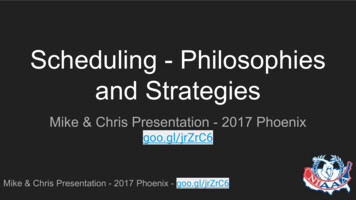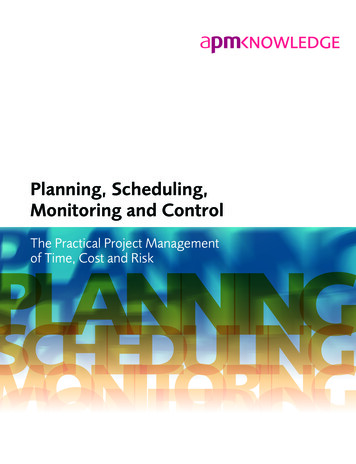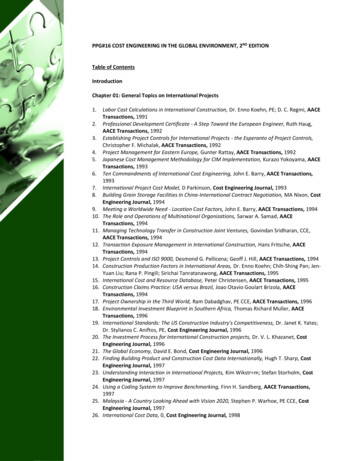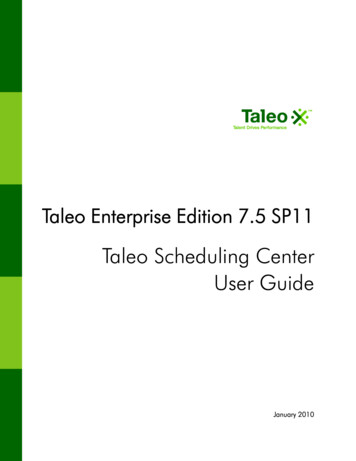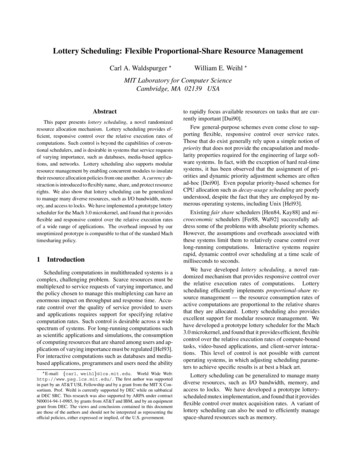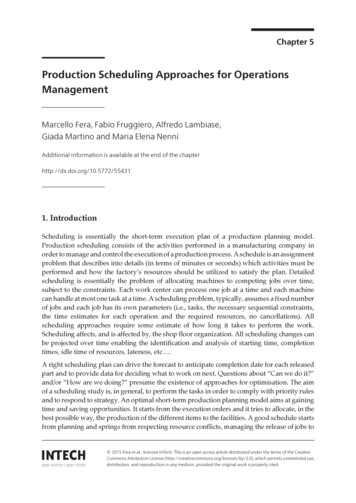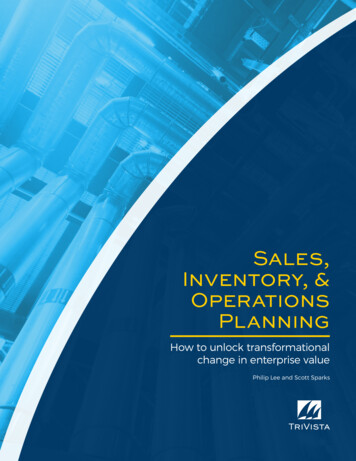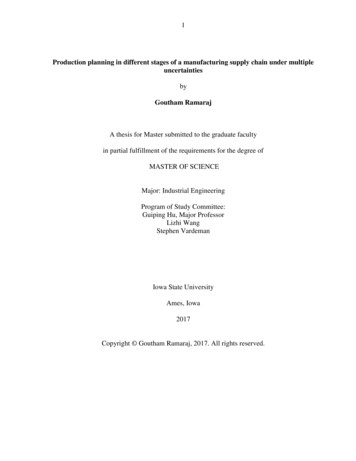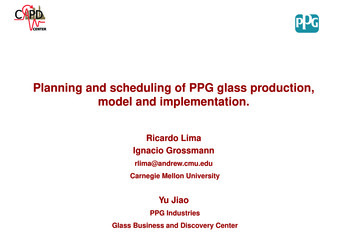
Transcription
Planning and scheduling of PPG glass production,model and implementation.Ricardo LimaIgnacio Grossmannrlima@andrew.cmu.eduCarnegie Mellon UniversityYu JiaoPPG IndustriesGlass Business and Discovery Center
Project scopeSupport Production Management Decisions Carnegie Mellon UniversityOptimal long-term production schedulingMaximize the profitsubject to:Scheduling constraintsProduct inventory constraintsWaste glass managementEWO meeting, September 2011 - p. 2
Project scopeSupport Production Management Decisions Optimal long-term production schedulingMaximize the profitsubject to:Scheduling constraintsProduct inventory constraintsWaste glass managementObjectives1. Development of a Mixed Integer Linear Programming (MILP)model for the planning and scheduling of the glassproduction Capture the essence of the process that is notconsidered in the Master Production Schedule Management of waste glass (cullet)2. Implement a user-friendly software tool to interface with theGAMS model.Carnegie Mellon UniversityEWO meeting, September 2011 - p. 2
Process and productsContinuous processFeatures 25 products defined by color, examples:,,, Sequence dependent changeovers between substrates Long transition times (order of days) High transition costs Complex recycleCarnegie Mellon University,,structure for cullet consumption and productionEWO meeting, September 2011 - p. 3
Problem statementGiven: Time horizon of 18 months Set of products deterministic demand initial, minimum, and maximum inventory levels production rates sequence dependent transitions operating costs selling prices Transition, and inventory costs Cullet initial, minimum, and maximum inventory levels production and consumption rates compatibility matrix between colors selling priceCarnegie Mellon UniversityEWO meeting, September 2011 - p. 4
Problem statementGiven: Time horizon of 18 months Set of products deterministic demand initial, minimum, and maximum inventory levels production rates sequence dependent transitions operating costs selling prices Transition, and inventory costs Cullet initial, minimum, and maximum inventory levels production and consumption rates compatibility matrix between colors selling priceDetermine: sequence of production (production times and amounts) inventory levels of products during and at the end of the time horizon inventory levels of cullet during and at the end of the time horizon economic terms: total operating, transition, inventory costsCarnegie Mellon UniversityEWO meeting, September 2011 - p. 4
Problem statementGiven: Time horizon of 18 months Set of products deterministic demand initial, minimum, and maximum inventory levels production rates sequence dependent transitions operating costs selling prices Transition, and inventory costs Cullet initial, minimum, and maximum inventory levels production and consumption rates compatibility matrix between colors selling priceDetermine: sequence of production (production times and amounts) inventory levels of products during and at the end of the time horizonThatandmaximizetheofprofit inventory levels of cullet duringat the endthe time horizon economic terms: total operating, transition, inventory costsCarnegie Mellon UniversityEWO meeting, September 2011 - p. 4
MILP planning and scheduling modelsModels implemented: Scheduling model: slot based continuous time model (Erdirik-Dogan and Grossmann, 2008)Planning model: traveling salesman sequence based (Erdirik-Dogan and Grossmann, 2008)Integrated using rolling horizon algorithms to cope with the complexity of the problem.(Lima andGrossmann, 2011)Carnegie Mellon UniversityEWO meeting, September 2011 - p. 5
MILP planning and scheduling modelsModels implemented: Scheduling model: slot based continuous time model (Erdirik-Dogan and Grossmann, 2008)Planning model: traveling salesman sequence based (Erdirik-Dogan and Grossmann, 2008)Integrated using rolling horizon algorithms to cope with the complexity of the problem.(Lima andGrossmann, 2011)Size and performance of the models, for two different case studiesApplication of both models without using a rolling horizon algorithmTime horizon 2 months, time periods 1 month, 22 products without culletScheduling modelIteration1EquationsVariables0-1 VariablesCPU (s)RGap (%)Obj4,2073,2531,21998.00.01,938.05Bi-level decomposition, first the planning model and then the scheduling modelIteration11EquationsVariables0-1 VariablesCPU (s)RGap 481,938.05Obj - value of objective function, profit.Carnegie Mellon UniversityEWO meeting, September 2011 - p. 5
MILP planning and scheduling modelsModels implemented: Scheduling model: slot based continuous time model (Erdirik-Dogan and Grossmann, 2008)Planning model: traveling salesman sequence based (Erdirik-Dogan and Grossmann, 2008)Integrated using rolling horizon algorithms to cope with the complexity of the problem.(Lima andGrossmann, 2011)Size and performance of the models, for two different case studiesApplication of both models using a rolling horizon algorithmTime horizon 15 months, time periods 1 month, 22 products with culletIter.EquationsVariables0-1 VariablesSlotsCPU (s)RGap 1043,41662,7503,004373,6000.7-4,291Obj - value of objective function, profit, but including penalties for violation of some constraints.Carnegie Mellon UniversityEWO meeting, September 2011 - p. 5
Implementation of the modelSoftware structure Main components: Model, GAMS, Excel Graphical User Interface (GUI) developed in VBA for Excel Manipulation of input data and output results structure developed in VBA for ExcelDataGUIInput Rxlsx - gdxSolve MathprogrammingmodelResultsWorksheetsExcelCarnegie Mellon UniversityEWO meeting, September 2011 - p. 6
Concluding remarks A customized decision support system for glass production is complete. In the scope of strategic studies in PPG, the model was used to analyze strategic product portfoliodecisions under production constraints. The results have indicated that changes in the current portfolio may result in higher profits.Carnegie Mellon UniversityEWO meeting, September 2011 - p. 7
Scheduling constraints Product inventory constraints Waste glass management Objectives 1. Development of a Mixed Integer Linear Programming (MILP) model for the planning and scheduling of the glass production Capture the essence of the process that is not considered in the Master Production Schedu
